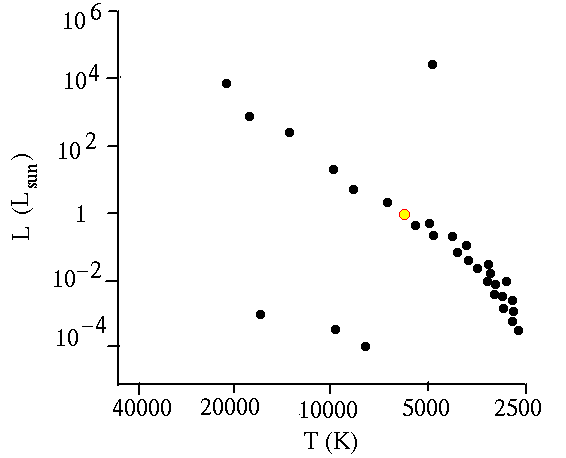
Okay, so far we have some basic ideas about distances, but how do we know that stars and the Sun are similar (or are they?).
First, by knowing their distances we can estimate how bright stars would be if we were close to them, and it turns out that many of the stars would have a similar brightness to our Sun.
Of course there are some stars which are much much fainter (eg. Proxima Centauri) or much much brighter (eg. Mu Cep and Betelgeuse).
In the early part of the 20th century, two astronomers made a remarkable discovery about stars. A German, Hertzsprung, and American, Russell, discovered that if you plot a graph of brightness against temperature for many stars, an amazing pattern emerges. An example of this diagram (now known as the Hertzsprung-Russell diagram) is shown below. The y-axis is L for luminosity (which just a measure of the star's brightness) and the x-axis is the temperature of the surface of the star.
Stars appear to have different colours depending on their temperature. They range from red, a cool 3,000 degrees to yellow, like our Sun, to blue, which are the hottest of all, at 20,000-50,000 degrees. Our Sun is marked as a yellow dot on the Hertzsprung-Russell diagram. It's pretty much middle of the range, in there with the rest of the gang. Stars like the Sun are known as main sequence stars - quite ordinary then!

Stars are massive, hot balls of gas which produce energy in their core. Their surface is hot and they emit light we can see and measure. From their light and spectra, we can learn a lot about them (see Peter's Fingerprint Adventure). There are stars which have a mass of only one hundredth of the mass of the Sun and there are other stars with a mass more than ten times the solar mass. Also the temperatures of stars vary from around three thousand degrees to up a few tens of thousands degrees. As you should know by now, from the other sections, the solar temperature is around 6000K.

|